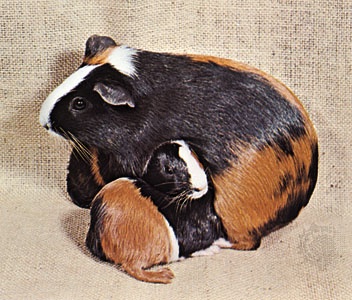guinea pig
rodent
 a domesticated species of South American rodent belonging to the cavy family (Caviidae). It resembles other cavies in having a robust body with short limbs, large head and eyes, and short ears. The feet have hairless soles and short, sharp claws; there are four toes on the forefeet, three on the hind feet. Domestic guinea pigs are fairly large, weighing 500 to 1,500 grams (roughly 1 to 3 pounds) and having a body 20 to 40 cm (8 to 16 inches) long; the tail is not visible externally. There is a crest of longer hairs at the neck, but length and texture of the fur vary from smooth (short or long) to coarse and short or long and silky. Coloration is extremely variable: the coat may be white, cream, tan, reddish or chocolate brown, black, or a combined pattern.
a domesticated species of South American rodent belonging to the cavy family (Caviidae). It resembles other cavies in having a robust body with short limbs, large head and eyes, and short ears. The feet have hairless soles and short, sharp claws; there are four toes on the forefeet, three on the hind feet. Domestic guinea pigs are fairly large, weighing 500 to 1,500 grams (roughly 1 to 3 pounds) and having a body 20 to 40 cm (8 to 16 inches) long; the tail is not visible externally. There is a crest of longer hairs at the neck, but length and texture of the fur vary from smooth (short or long) to coarse and short or long and silky. Coloration is extremely variable: the coat may be white, cream, tan, reddish or chocolate brown, black, or a combined pattern.Guinea pigs eat vegetation and do not require water to drink if supplied with sufficiently moist food, but they must have water if fed dry commercial food. They breed all year in captivity, with females bearing up to 13 young per litter (4 is average); gestation takes 68 days. Although the young can scamper about and eat solid food the day they are born, they are not fully weaned for about three weeks. Females mature in two months, males in three, and captive guinea pigs live up to eight years, although three to five is typical.
No natural population of this species exists in the wild. Guinea pigs were apparently domesticated more than 3,000 years ago in Peru, coinciding with humans' transition from a nomadic to an agricultural lifestyle. The Incas (Inca) kept guinea pigs, and the animals were bred during the same period by tribes along the Andes Mountains from northwestern Venezuela to central Chile. These rodents remain a sustainable food source for the native peoples of Ecuador, Peru, and Bolivia, who either keep them in their homes or allow them to scavenge freely both indoors and out. Guinea pigs were taken to Europe in the 16th century, and since the 1800s they have been popular as pets (pet). They are also used internationally as laboratory animals for studies of anatomy, nutrition, genetics, toxicology, pathology, serum development, and other research programs.
There are four other, nondomesticated members of the genus Cavia that are also called guinea pigs: the Brazilian guinea pig (C. aperea) found from Colombia, Venezuela, and the Guianas south to northern Argentina; the shiny guinea pig (C. fulgida) inhabiting eastern Brazil; the montane guinea pig (C. tschudii) ranging from Peru to northern Chile and northwestern Argentina; and the greater guinea pig (C. magna) occurring in southeastern Brazil and Uruguay. Breeding and molecular studies suggest that the domestic guinea pig was derived from one of the wild Brazilian, shiny, or montane species.
- Max Eyth
- Max Factor
- Max Faget
- Max Ferdinand Perutz
- Maxfield Parrish
- Max Frisch
- Max Gluckman
- Max Hoffmann
- Max Horkheimer
- Max Hussarek, Baron Hussarek von Heinlein
- Max Hussarek Hussarek von Heinlein, Baron
- Ma-Xia school
- Maxie Anderson
- Maxillaria
- Maxime Bôcher
- Maxime Du Camp
- Maxime Weygand
- Maxim, Hiram Percy
- Maxim, Hudson
- Maximian
- Maximilian
- Maximilian Felix Ernst Harden
- Maximilian Franz August von Forckenbeck
- Maximilian Freiherr von Gagern
- Maximilian, Graf von Spee